The Treasurer’s Office is experiencing heavier than normal call volume. Phone lines are operational, but the volume of calls is overloading the system. If you receive a busy signal, please place your call again. We apologize for the inconvenience.
Blog
-
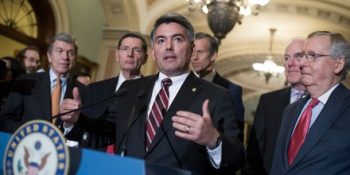
Developments from Cory Gardner US Senator for Colorado
The Connected Government Act Heading to the President’s Desk
WASHINGTON –The bipartisan Connected Government Act, which was introduced by Senators Cory Gardner (R-CO) and Maggie Hassan (D-NH), passed the Senate and is heading to President Trump’s desk for signature. The bipartisan measure will expand access to government services and information by requiring all new federal websites to be mobile-friendly. The Connected Government Act will support low-income Americans who rely on mobile broadband at higher rates, as well as the 80 percent of Americans who experience disabilities who use wireless technology every day.
I am thrilled that this common-sense piece of bipartisan legislation has passed the Senate and is on its way to the President’s desk. As more and more Americans rely on their mobile devices to access information and websites, it’s important the federal government has websites designed for mobile platforms. The Connected Government Act will promote transparency and bring the government into the 21st century. — Senator Gardner
“As mobile devices continue to surpass desktop use for accessing the internet, it is important that the federal government is up to speed with the latest technology that allows our people and economy to thrive,” Senator Hassan said. “I am pleased that the bipartisan Connected Government Act passed the Senate, and I urge President Trump to sign the bill into law as quickly as possible so that Granite Staters and Americans who use mobile technology, including low-income individuals and Americans who experience disabilities, can access government services, resources, and information to help them succeed.”
The Connected Government Act requires all new government websites intended to be used by the public to be mobile-friendly. The bill also requires the General Services Administration to submit a report to Congress on agency compliance with this law within 18 months of enactment. Congresswoman Robin Kelly (D-IL) and Frank Pallone (D-NJ) introduced the companion to this bill in the U.S. House of Representatives. The bill passed the U.S. House of Representatives on November 15, 2017.
See Bill text here.
Gardner Supports Potential CHIP Funding Extension
Washington, D.C. – Senator Cory Gardner (R-CO) released the below statement regarding discussions to allow the Department of Health and Human Services (HHS) to provide sufficient funding for the Children’s Health Insurance Program (CHIP) to March 31st in the Continuing Resolution (CR) that Congress will consider as soon as today. Cancellation notices for Colorado are expected to go out on December 26th if Congress does not act this week to extend funding.
I will do everything I can to ensure that the 90,000 Colorado children and pregnant mothers that utilize CHIP do not go a day without this funding. While the five year extension of CHIP funding that Senator Bennet and I continue to push in the Senate is by far the best path forward for Coloradans, absent movement on that legislation today we need to make sure funding is extended past Colorado’s deadline of January 31st. I support the inclusion of language in the must-pass CR that allows CHIP funding to continue while a long-term bipartisan agreement is worked out. — Gardner said
Senator Gardner is one of six Republicans to sponsor The Keeping Kids’ Insurance Dependable and Secure (KIDS) Act, legislation to extend CHIP funding through Fiscal Year (FY) 2022.
Colorado Fruit & Vegetable Assoc. Seeks to Fix Foreign Worker Program
The Colorado Fruit & Vegetable Growers Association (CFVGA) met last week with the staff of Sen. Michael Bennet, D-Colo., and with Sen. Cory Gardner, R-Colo., to appeal for quick legislative action to fix the current foreign worker program before the 2018 growing season. The appeal comes as Colorado fruit and vegetable growers contemplate if they can continue to grow produce given the extreme labor shortage of qualified and willing farm laborers.
Federal legislation to replace the current H2A foreign agricultural worker program, dubbed H2C, was introduced this past fall.
“Even though the current program has its shortfalls, causing Colorado growers to be less competitive in the world market, the proposed H2C program would be even worse,” said CFVGA President Robert Sakata, Sakata Farms, Brighton, Colo.
“Let’s not be under the illusion that foreign, temporary produce workers are taking American jobs,” Bruce Talbott, Talbott Mountain Gold, Palisade, Colo., told both senators. “In all the time we’ve used the H2A program, we’ve had two of 200 foreign workers not complete a contract. During that same time, we’ve had only two Americans complete contracts, and that is only because we have moved them into equipment operation jobs. Our foreign workers return year after year and are glad to have the work and what we pay them. Americans just do not want this intensive work for a time limited harvest season.”
Talbott and other growers told the senators the H2A requirements for recruiting American workers are burdensome and costly with virtually no return on their efforts and that the requirements also create untimely delays getting workers.
Ryan Fagerberg, Fagerberg Produce, Eaton, Colo., said 2017 was the first year his family’s operation used H2A. “We were happy with the results and the assurance we would have the labor we needed, but it did increase our labor costs 30-40 percent, due to the additional fees, travel costs for workers and housing requirements.”
Gardner told the growers he believes there is a better chance of enacting a good guest worker program once legislation to secure the border is put in place. He believes this action needs to be taken prior to expiration of the DACA program, which enables children brought to the United States illegally by their parents to remain and seek citizenship.
“I don’t know how much longer we will be able to continue raising fruits and vegetables, given all the regulatory requirements, and even more so this labor shortage,” said David Asbury, Rocky Mountain Pumpkin Ranch, Longmont, Colo. “The H2A program requires us to provide housing for our workers, but renting houses for such a short period is difficult, and here in Boulder County, the average cost of a home is $400,000, with prices in Boulder itself close to $1 million. That isn’t sustainable.”
CFVGA produce growers attending these meetings, told both senators that an effective guest worker program must:
- Not have a worker cap limiting the number of seasonal agricultural workers
- Change the requirements to recruit American laborers that more closely fit local availability
- Not require e-Verify, a system that has slowed hiring and flagged legal workers inaccurately until a workable seasonal guest worker is up and running and the E-verify system is accurate and reliable
- Change housing requirements to allow employers to provide housing vouchers in lieu of providing housing and making housing requirements compatible with local community availability
- Calculate the wage rate for guest workers on a more realistic basis, rather than the current adverse wage rate, taking into consideration the financial benefits of housing and transportation that are provided
- Move program to the U.S. Department of Agriculture, which understands agricultural operations, especially the time-sensitivity of agricultural labor
- Allow area farmers to share guest workers to meet ever changing operational needs
- Provide flexibility to meet the needs of shorter growing and harvest seasons of produce growers in states with seasonal production
HELP US SPREAD THE NEWS
COMMENT, Like, Follow & SHARE to get your daily dose of Tips, Tricks, News and Events! @I70Scout
RELATED NEWS CURRENT EDITION
WEATHER & TRAFFIC PUZZLES RECENT NEWS ADVERTISE WITH US
-

A Look Back at the Rocky Mountain Economy 100 Years Ago
Alison Felix, Sam Chapman,
The Federal Reserve System was created in late 1913. In addition to establishing 12 regional Reserve Banks, the Federal Reserve Act extended that regional presence by providing for Branch offices, saying that “each Federal Reserve Bank shall establish Branch Banks within the Federal Reserve District in which it is located.” The Denver Branch of the Federal Reserve Bank of Kansas City opened Jan. 14, 1918. As the Branch approaches its centennial, this issue of the Rocky Mountain Economist examines how the economies of Colorado, New Mexico and Wyoming have been transformed over the past 100 years.
Population Growth over the Past 100 Years
The Rocky Mountain States were still relatively new when the Denver Branch opened in 1918, with New Mexico entering statehood just six years prior. Among the three states, Colorado was the largest in 1918 with a population of 906,000, followed by New Mexico with 382,000, and Wyoming with 181,000 (Chart 1). Of course, populations have increased substantially since then, with growth in Colorado and New Mexico far outpacing the pace of growth at the national level (Chart 2).

Colorado’s population increased more than 500 percent between 1918 and 2016, an average annualized growth rate of 1.9 percent. New Mexico experienced similar rates of growth with average annual growth of 1.7 percent over the same period. Population growth in New Mexico outpaced Colorado in 31 of the 43 years from 1918 to 1960, but this trend has reversed in more recent years as Colorado‘s rate of population growth was higher than its southern neighbor in 42 of the 56 years from 1961 to 2016. In recent years, population growth has slowed dramatically in New Mexico due in part to some out-migration. From 2010 to 2016, annualized growth averaged 1.6 percent in Colorado compared to 0.1 percent in New Mexico.
Population growth rates for Wyoming and the United States have trended closely together over the last century, although Wyoming’s growth has been more volatile. The energy sector has played a substantial role in recent decades in Wyoming’s economy and population growth. In particular, Wyoming’s population soared during the energy boom in the early 1980s and then fell sharply as energy prices fell. Averaging over these fluctuations, annualized population growth rates over the last 100 years for the nation and Wyoming were both about 1.2 percent.
As population in the Rocky Mountain States grew, the distribution across the states shifted from nonmetropolitan areas to metropolitan areas. Map 1 shows the share of total state population by county in 1920, 1960 and 2016. In 1920, people were more dispersed geographically across the states compared to 2016, especially in New Mexico and Wyoming. Colorado’s population was relatively concentrated along the Front Range and Western Slope near Grand Junction in 1920, but there were also pockets in the south near Trinidad as well as the northeast that had higher concentrations than today. The counties with the largest populations for each state in 1920 were Denver County, CO at 256,000; Bernalillo County, NM (Albuquerque) at 30,000; and Laramie County, WY (Cheyenne) at 21,000.
Between 1920 and 1960, the population of the Rocky Mountain States increasingly moved from more rural areas into cities such as Casper, Cheyenne, Colorado’s Front Range cities, Grand Junction, Albuquerque and Las Cruces. This trend represents both regional and national effects, as gold mining prospects faded away and technological developments in agriculture led to fewer people needed to farm larger areas. This trend continued, and between 1960 and 2016 population shares increasingly moved into metropolitan areas. By 2016, the largest counties in each state remained the same as in 1920, but the share of the state population had increased from 13 to 27 percent in Denver County; from 8 to 33 percent in Bernalillo County; and from 11 to 17 percent in Laramie County.i
Employment Trends over the Past Century
Similar to population, the level of employment over the last century in the Rocky Mountain States has steadily increased (Chart 3). However, employment gains have exceeded population gains over the past 100 years as labor force participation rates have increased for women.
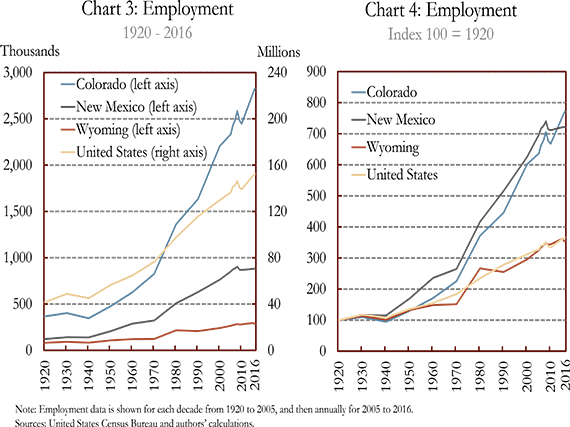
Indexing the 1920 employment to equal 100 makes it easier to see that employment growth rates in Colorado and New Mexico have been similar over the past century, whereas Wyoming employment growth has trended more closely with that of the United States (Chart 4). Specifically, from 1920 to 2016, employment in Colorado and New Mexico grew at average annualized rates of 2.2 and 2.1 percent, respectively, while employment in Wyoming and the United States expanded at average annualized rates of 1.3 and 1.4 percent, respectively. Similar to population trends, growth in Wyoming’s relatively small employment base was more volatile than that of the United States due in large part to its heavy reliance on the energy sector.
The decade with the fastest employment growth was the 1970s, when annualized growth rates were 2.5 percent at the national level and between 4 and 6 percent in the Rocky Mountain States. This was primarily due to a surge of women entering the workforce; the rate of employment growth for women in the United States was twice as fast as that for men in the 1970s. As a result, the share of women in the workforce increased from 37.7 percent in 1970 to 42.4 percent in 1980.
Another notable period was the Great Depression during the 1930s, when all of the Rocky Mountain States and the nation experienced a decline in employment. The recent Great Recession of 2007-09 also caused significant job losses totaling about 5 percent for the Rocky Mountain States and the United States, as evident by the steep drops in Charts 3 and 4. As of October 2017, Colorado’s employment was well above its pre-recession peak from 2008 by 12.5 percent, more than double U.S. growth in the same period of 6.2 percent. New Mexico is very close to surpassing its pre-recession peak as it is only 0.7 percent below its 2008 peak. Wyoming, on the other hand, has experienced falling employment over the last three years due to the recent downturn in the energy sector and is now 8.1 percent below its pre-recession peak from 2008.
In addition to the growth in employment levels, there has been a considerable shift over the past century in the industry mix of employed workers (Chart 5). Technological advancements and changes in consumer preferences over the last 100 years have shifted resources, including labor, into different industries across the economy. New industries, such as those pertaining to information technology, have formed over time while some industries have been phased out or employ fewer workers.
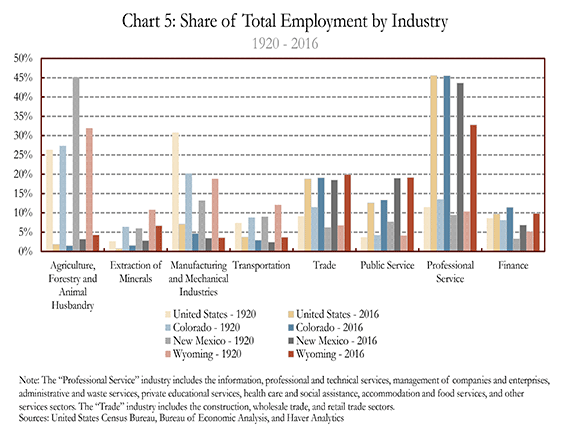
There is a stark contrast between the largest industries in 1920, shown by the lighter-shaded bars, to the largest industries in 2016, shown by the darker-shaded bars. In particular, workers have shifted from agriculture, manufacturing and related industries toward more service-oriented industries. Advancements in technology have had a huge impact on the agriculture sector as a smaller share of the total workforce is needed to produce a greater amount of output. Overall, the share of the workforce employed in the agriculture sector has fallen from more than 25 percent in 1920 to less than 5 percent today. As technology advanced and the national population base increasingly moved west, the economies of the Rocky Mountain States were able to diversify.
The Rocky Mountain States have a rich mining history; the industry attracted many individuals to the region in the 19th and early 20th centuries. The high concentration of minerals and agricultural products were heavily relied upon by local manufacturing firms, which depended on raw materials for their inputs. However, similar to the agriculture industry, technological development has also occurred in the manufacturing sector across the United States. Specifically, improvements in technology have led to productivity gains in manufacturing, meaning fewer workers are needed to produce a given amount of product. The expansion of international trade has also led to increased competition and a rise in off-shore production of some manufactured goods. These forces, along with increased demand for service-oriented industries, have led to a decline in the share of manufacturing employment in the Rocky Mountain States from more than 13 percent in 1920 to fewer than 5 percent in 2016.
While the share of workers in the agriculture, mining and manufacturing sectors has declined over the past century, the share of workers in services sectors has increased significantly. In particular, employment in the professional service industry has grown from about 10 percent of total employment in 1920 to about 45 percent in 2016 for Colorado, New Mexico and the nation, and 33 percent in Wyoming. The increasingly heavy reliance upon service-oriented sectors over the last 100 years is not unique to the United States, but is a trend that has occurred in many of the world’s advanced economies. Efficiency gains in the production of manufacturing and agriculture have accommodated a shift in labor resources toward new service-oriented industries.ii The professional service industry includes a wide variety of sectors such as private educational services, health care, leisure and hospitality, information, and other professional and technical services such as legal services, advertising, engineering and accounting. The health-care sector is particularly noteworthy, as its share of total employment over the last 100 years has increased from less than 2 percent of total employment in 1920 to around 10 percent in 2016 in the Rocky Mountain States and the nation.
Per Capita Income Growth since 1929
As the economies of the Rocky Mountain States have advanced and productivity has risen, so too has the income of its population. Chart 6 shows the evolution of real per capita income in the Rocky Mountain States and the nation from 1929, the first year this data is available, to 2016. Since 1929, per capita income has increased significantly, even after adjusting for inflation, suggesting that standards of living during that time have improved significantly on average.
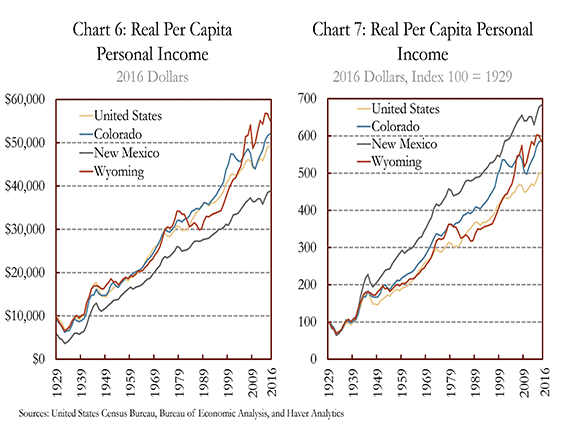
In 1929, real per capita income was close to $10,000 in Colorado, Wyoming and the United States and slightly below $6,000 in New Mexico. Income growth during the following 10 years was fairly static, as the Great Depression pulled down incomes across the nation. Real per capita income increased sharply during World War II as more women entered the workforce, and then decreased slightly after the war ended. Key regional industries can also have a big impact on income patterns. For example, the energy crisis of the 1980s had a large negative impact on per capita income in Wyoming, while the build-up in the technology sector in Colorado in the 1990s had first a positive and then a negative effect on per capita income.
In more recent years, the Great Recession led to a decline in real per capita income, with Colorado and Wyoming experiencing declines of about 10 percent and the United States and New Mexico experiencing declines closer to 4 percent. Since then, all geographic areas have surpassed their pre-recession peaks for real per capita personal income, although Wyoming’s per capita income has fallen since 2014 when energy prices began to fall sharply. Over the entire period from 1929 to 2016, New Mexico has realized the fastest pace of per capita income growth in the region, but the level of per capita income in New Mexico remains below national levels.
Conclusion
The economies of the Rocky Mountain States have undergone significant change over the last 100 years. Employment and population growth has kept pace with national gains in Wyoming, while Colorado and New Mexico have witnessed much faster growth. Over the same period, the population has increasingly moved toward metropolitan areas, and employment has shifted away from agriculture and manufacturing into areas such as trade and professional service. Finally, real per capita personal income growth has increased significantly in the Rocky Mountain States, improving the standard of living across the region.
End notes
i. It is worth noting that the combined population share of the Denver-Aurora-Lakewood Metropolitan Statistical Area of Adams, Arapahoe, Broomfield, Clear Creek, Denver, Douglas, Elbert, Gilpin, Jefferson and Park counties increased from 33.6 percent in 1920 to 51.5 percent in 2016.
ii. Rowthorn, Robert, and Ramana Ramaswamy. Deindustrialization – Its Causes and Implications.International Monetary Fund, September 1997.
-Article credit: Federal Reserve Bank of Kansas City
SPREAD THE NEWS
COMMENT, Like, Follow & SHARE @I70Scout
CURRENT EDITION
WEATHER & TRAFFIC PUZZLES RECENT NEWS ADVERTISE WITH US
-

January 2018 at Denver Art Museum: A creative new year, last days for Her Paris and Other Returns
Make it a creative new year at the Denver Art Museum in January
The museum will be open Dec. 31 and Jan. 1. There’s always plenty for families to do at the DAM. Through Jan. 7 during Winter Break enjoy performances of the family-friendly play Art Emergency: Stampede Edition at 11 a.m. weekdays (except Dec. 25, Jan. 1 and 4), Create-n-Takes, and explore animal-themed artmaking activities in the DAM’s newest family space, A Walk in the Woods. And don’t forget to visit the 3-D Studio, with hands-on fun available whenever the museum is open and weekend demonstrations by local artists and creatives from noon-3 p.m.
Adults are invited to get creative, too. The 2018 Untitled season kicks off Jan. 26 with an evening of offbeat fun guest-curated by composer Nathan Hall and dancer Laura Ann Samuelson. The three-part course, Fiber Art in the Museum with Steven Frost, will introduce participants to working with fabric, yarn and thread in a contemporary art practice. Our monthly drop-in drawing and drop-in writing programs continue, as well as Mindful Looking, a chance to slow down and savor a single work of art. On Jan. 16, get to know Deborah Butterfield’s whimsical horse sculptures Willy, Argus and Lucky.
How can art help us discuss contemporary social issues? On Jan. 12 at a new program, Exchange, explore the theme of free speech with comic Janae Burris, poet Jen Harris, Sarah Magnatta from the University of Denver and Jim Walsh, founder of the Romero Theater Troupe, using the exhibition Eyes On: Xiaoze Xie as a starting point.
Other upcoming lectures and events include a full-day symposium titled Beyond America’s Heartland: Regionalism and the Art of the American West (Jan. 4), Conversation with a Curator: Eyes On: Xiaoze Xie (Jan. 5), and Animate Architecture in the Yucatán Peninsula (Jan. 18). London-born and New York-based Shantell Martin—whose largest artwork to date is currently covering the sidewalks of a downtown Denver plaza—is the first speaker in the Logan Lectures Spring 2018—Artists on Art: From Any Angle series on Jan. 17.
Time is running out to see Her Paris: Women Artists in the Age of Impressionism, on view through Jan. 15, 2018. Debuting nationally in Denver, this special ticketed exhibition features more than 80 paintings by 37 women artists from across Europe and America, who migrated to this epicenter of art to further their careers. They range from well-known artists such as Berthe Morisot, Mary Cassatt and Rosa Bonheur, to painters who are lesser-known in the United States, including Anna Ancher and Paula Modersohn-Becker. Advance ticket purchase recommended; tickets for youth 6-18 are only $5 and children five and younger are free.
Other exhibitions on view include the multi-departmental exhibition Stampede: Animals in Art, Linking Asia: Art, Trade, and Devotion, Ganesha: The Playful Protector, Past the Tangled Present and Eyes On: Xiaoze Xie. Daily exhibition tours are offered of Stampede at 1 p.m. and Linking Asia at 2 p.m.
The Hamilton Building is now open seven days a week, and the North Building is closed for renovations.
SPREAD THE NEWS
COMMENT, Like, Follow & SHARE @I70Scout
CURRENT EDITION
WEATHER & TRAFFIC PUZZLES RECENT NEWS ADVERTISE WITH US
-
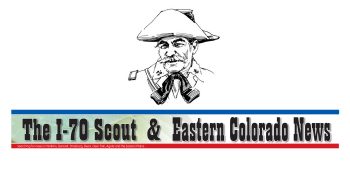
Denver Metro Action Day for Visibility
Indoor Burning Restrictions in Effect
This is the Denver Metro Air Pollution Forecast effective 4PM on Tuesday, December 26, 2017:
An Action Day for Visibility is now in effect for the seven-county Denver-Boulder metropolitan area. Indoor Burning Restrictions and requests to limit driving are now in effect until at least 4 PM Wednesday, December 27, 2017. Poor visibility and an exceedance of the state visibility standard are expected on Wednesday. Otherwise, good or moderate air quality conditions are expected. No other air quality advisories are in effect.
Cold, stagnant overnight conditions will lead to Poor visibility on Wednesday.
For statewide conditions, forecasts and advisories, visit:
http://www.colorado.gov/airquality/colorado_summary.aspxA poorly maintained vehicle pollutes more than a well maintained one. If you must drive, properly maintain your vehicle. We’ll all breathe easier!
At 2PM (MST), Tuesday, 12/26/2017 the highest AQI value was 62 for Particulate less than 2.5 micrometers which indicates Moderate air quality. Respiratory symptoms possible in unusually sensitive individuals, possible aggravation of heart or lung disease in people with cardiopulmonary disease and older adults. Unusually sensitive people should consider reducing prolonged or heavy exertion.
Front Range Air Quality Forecast & Colorado Smoke Outlook
FRONT RANGE AIR QUALITY FORECAST:
Tuesday, December 26, 2017, 2:15 PM MSTOzone concentrations are expected to be in the Good category on Tuesday and Wednesday.
Fine Particulate Matter concentrations are expected to be in the Good to Moderate range on Tuesday and Wednesday. Moderate concentrations of fine particulates are most likely in the Denver Metro Area on Tuesday, expanding into Southern Weld County including Greeley on Wednesday. In these areas unusually sensitive people should consider reducing prolonged or heavy exertion on Tuesday and Wednesday.
Carbon Monoxide concentrations are expected to be in the Good category on Tuesday and Wednesday.
Nitrogen Dioxide concentrations are expected to be in the Good category on Tuesday and in the Good to Moderate range on Wednesday. Moderate concentrations of nitrogen dioxide are most likely for locations within the Denver Metro area near busy roadways, particularly between the hours of 6-10 MA, and again between 5-9 PM. In these areas unusually sensitive people should consider reducing prolonged or heavy outdoor exertion on Wednesday.
Visibility is expected to be Moderate to Poor on Wednesday.
-

Denver Broncos began 2017 ensnared in a dreaded quarterback competition
By ARNIE STAPLETON
AP Pro Football Writer
ENGLEWOOD (AP) — The Denver Broncos began 2017 ensnared in a dreaded quarterback competition and they’re ending the year entangled in another.
Paxton Lynch lost out to Trevor Siemian last summer and it’s doubtful after missing most of the season that he could beat out Brock Osweiler this week in a fair fight.
But this week is about splitting snaps at practice, not even-handedness.
Osweiler is coming off one of the best performances of his career, “but we have to consider the team’s future at quarterback,” coach Vance Joseph said Thursday. “That’s fair for all of us.”
The Broncos want to see Lynch play over the final two weeks so they can have more fodder to determine if their 2016 first-round pick is a bust or a late-bloomer.
Ideally, the Broncos would prefer to have one QB taking almost all the snaps as Peyton Manning used to. That’s how offenses build cohesion, develop rhythm and create chemistry.
There aren’t really any workarounds to finding all those attributes while still searching for answers under center.
“How do you make up for it? Well, you kind of don’t. That’s why most teams don’t do it,” Joseph said Thursday .
“It’s not ideal to play three guys and have three different starters. It’s not what you want to do, but that’s where we’re at. We’re going to play the hand we’re dealt and make the best of it.”
The knock on Siemian coming into the year was that he was injury-prone, and he went on IR last week with an injured left shoulder.
Lynch has proven even more fragile, however.
He sprained his left shoulder in the preseason and his recovery was excruciatingly slow. He was inactive for the first nine games and made his 2017 debut at Oakland last month, where he was knocked from the game in the third quarter and spent the remainder of the game sobbing on the sideline over a sprained left ankle.
Inactive the past three weeks, he’ll at the very least be active Sunday at Washington when the Broncos (5-9) visit the Redskins (6-8) , and next week against Kansas City.
“I’ll say this, our goal is to see him play before the year is out,” Joseph said. “We have two more games to do that. My concern is making sure he’s healthy enough to play at a high level. He has an ankle injury and he hasn’t practiced in three weeks. He’s a quarterback that can use his legs when he’s in danger, so I want to make sure he’s right. That’s about it.”
Lynch’s grasp of pro offenses and defenses, his maturity level and his work ethic have all come into question since general manager John Elway moved up in the 2016 draft to select him.
But it’s his health that’s holding him back right now and that’s what could lead to Osweiler getting the start Sunday.
Lynch has been limited at practice all week.
“That’s the issue. That’s why we’re taking our time trying to figure out if he’s ready to play, so we can evaluate him,” Joseph said. “That’s why we didn’t name a guy yesterday or the day before.”
Osweiler led Denver to three TDs and had a 147.7 passer rating in Denver’s 25-13 come-from-behind win at Indianapolis after Siemian was knocked from the game with an injury to his left, non-throwing shoulder.
Once Peyton Manning’s heir apparent, Osweiler left for Houston in free agency in the aftermath of Denver’s Super Bowl 50 victory last year, but he found his way back to Denver this summer after being traded by the Texans and released by the Browns.
He compared his departure from Denver to touching the hot stove as an inquisitive youngster “and you learn real quick how nice that stove is when it’s not hot.”
Although Osweiler loves Colorado, he might have once again priced himself out of the Broncos’ plans with his superb relief performance last week as he’ll be one of the more experienced quarterbacks to hit free agency this spring.
NOTES: CB Chris Harris Jr. said he feels he didn’t get a Pro Bowl nod because he’s only been targeted 48 times — second fewest among the league’s starting cornerbacks — and therefore couldn’t put up big numbers as he has in the past. He said next season he hopes the Broncos keep him outside and quit moving him into the slot, which he said diminishes his chances to make game-changing plays.
-
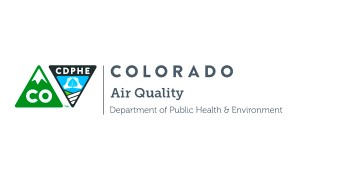
Denver Metro — Action Day for Visibility
Indoor Burning Restrictions in Effect
This is the Denver Metro Air Pollution Forecast effective 4PM on Thursday, December 21, 2017:
An Action Day for Visibility is now in effect for the seven-county Denver-Boulder metropolitan area. Indoor Burning Restrictions and requests to limit driving are now in effect until at least 4 PM Friday, December 22, 2017. Poor visibility and an exceedance of the state visibility standard are expected on Friday. Otherwise, good or moderate air quality conditions are expected. No other air quality advisories are in effect.
Cold and stagnant conditions will lead to Poor visibility on Friday.
For statewide conditions, forecasts and advisories, visit:
http://www.colorado.gov/airquality/colorado_summary.aspxA poorly maintained vehicle pollutes more than a well maintained one. If you must drive, properly maintain your vehicle. We’ll all breathe easier!
At 2PM (MST), Thursday, 12/21/2017 the highest AQI value was 50 for Particulate less than 2.5 micrometers which indicates Good air quality.
Front Range Air Quality Forecast & Colorado Smoke OutlookFRONT RANGE AIR QUALITY FORECAST:
Thursday, December 21, 2017, 2:20 PM MSTOzone concentrations are expected to be in the Good category on Thursday and Friday.
Fine Particulate Matter concentrations are expected to be in the Good to Moderate range on Thursday and Friday. Moderate concentrations of fine particulates are most likely in the Denver Metro Area and northward along the Front Range urban corridor into southern Weld County including Greeley. In these areas unusually sensitive people should consider reducing prolonged or heavy exertion on Thursday and Friday.
Carbon Monoxide concentrations are expected to be in the Good category on Thursday and Friday.
Nitrogen Dioxide concentrations are expected to be in the Good to Moderate range on Thursday and Friday. Moderate concentrations of nitrogen dioxide are most likely in the Denver Metro Area near busy roadways, particularly between the hours of 5-9 PM on Thursday evening and again between 6-10 AM on Friday morning. In these areas unusually sensitive people should consider reducing prolonged or heavy outdoor exertion on Thursday and Friday.
Visibility is expected to be Moderate to Poor on Friday.
COLORADO SMOKE OUTLOOK:
Thursday, December 21, 2017, 2:20 PM MSTLight to moderate smoke is possible near prescribed fires and small wildfires around the state.
What if there is a wildfire or smoke in your area?
The focus of the Colorado Smoke Outlook is on large fires (e.g., greater than 100 acres in size). Nevertheless, smoke from smaller fires, prescribed fires, and/or smoke from new fires not yet known to CDPHE air quality meteorologists may cause locally heavy smoke. If there is smoke in your neighborhood, see the public health recommendations below.
Public health recommendations for areas affected by smoke: If smoke is thick or becomes thick in your neighborhood you may want to remain indoors. This is especially true for those with heart disease, respiratory illnesses, the very young, and the elderly. Fine particulates may reach the Unhealthy category where smoke is heavy. Consider limiting outdoor activity when moderate to heavy smoke is present. People with heart or lung disease, older adults, and children should avoid prolonged or heavy exertion; everyone else should reduce prolonged or heavy exertion. Consider relocating temporarily if smoke is present indoors and is making you ill. IF VISIBILITY IS LESS THAN 5 MILES IN SMOKE IN YOUR NEIGHBORHOOD, SMOKE HAS REACHED LEVELS THAT ARE UNHEALTHY.
Winter High Pollution Advisory Program
The Winter High Pollution Advisory Program is coordinated by the Air Pollution Control Division of the Colorado Department of Public Health and Environment.
Winter season air pollution forecasts are issued daily from October 31 through March 31 at 4 p.m. When conditions warrant, forecasts will include information about Action Days and subsequent indoor burning restrictions.
An Action Day for fine particulates, carbon monoxide or ozone indicates that either current air quality is unhealthy or conditions are expected to worsen later in the day or on the next day. Action Days for air pollutants generally indicate that air quality will be in either the Unhealthy or Unhealthy-for-Sensitive-Groups categories according to the Air Quality Index. Action Days trigger mandatory restrictions that limit indoor burning to approved devices only (see indoor burning below), voluntary driving reductions, and public health recommendations.
An Action Day for Visibility alone indicates that the Visibility Standard Index for visual air quality is expected to be poor on the current or following day. An Action Day for Visibility will trigger mandatory restrictions on indoor burning and voluntary driving reductions for the seven-county Denver-Boulder metropolitan area only.
When no advisories are issued, air quality is good or moderate and is expected to remain so during the effective period of the forecast. No restrictions are in place.
Additional Information
ACTION DAYS: An Action Day for fine particulate matter (particulates), carbon monoxide, ozone or other pollutants indicates that either current air quality is unhealthy or conditions are expected to worsen later in the day or on the next day. Action Days for air pollutants generally indicate that air quality will be in either the Unhealthy or Unhealthy-for-Sensitive-Groups categories according to the Air Quality Index. Action Days trigger voluntary pollution prevention measures, which may vary by season, and public health recommendations. In addition, during the winter ‘high pollution day’ season (October 31 to March 31), Action Days trigger mandatory restrictions that limit burning inside the home to approved devices only (see indoor burning below).
Action Days for Visibility alone are issued during the winter ‘high pollution day’ season (October 31 to March 31), only. At the time they are issued (4 PM), action days for visibility indicate that the Visibility Standard Index for visual air quality is expected to be poor on the following day. Action Days for Visibility trigger mandatory restrictions that limit indoor burning to approved devices only and voluntary driving reductions for the seven-county Denver-Boulder metropolitan area .
The VISIBILITY STANDARD INDEX reports the air’s visual quality in the seven-county Denver-Boulder metropolitan area. The visibility standard is 0.076 per kilometer of atmospheric extinction, which means that 7.6 percent of the light in a kilometer of air is blocked. The level must exceed the standard based on a four-hour average for a violation to occur. On the Visibility Standard Index Scale, a value of 101 equates to the 0.076/km standard. Values between 0-50 are good, 51-100 moderate, 101-200 poor and 201-plus extremely poor.
The AIR QUALITY INDEX reports the daily level of air pollution on an hourly basis. The index reports the highest level of either carbon monoxide, fine particulates or ozone depending on which pollutant has the greatest hourly concentration. Values greater than 100 for carbon monoxide, fine particulates and ozone indicate exceedances of the pollutant’s state and federal standards. Air Quality Index values between 0-50 are good, 51-100 moderate, 101-150 unhealthy for sensitive groups, 151-200 unhealthy, 201-300 very unhealthy, and over 300 hazardous.
INDOOR BURNING: On Action Days issued during the winter ‘high pollution day’ season (October 31 through March 31), mandatory restrictions that limit indoor burning to approved devices only generally apply to everyone in the entire seven-county Denver-Boulder metropolitan area below 7,000 feet . The restrictions will be enforced through local ordinances or a state regulation.
The state regulation applies to any community in the seven-county Denver-Boulder metropolitan area that did not have its own mandatory indoor burning ordinance in effect on January 1, 1990. Under this regulation, the only exceptions to the burning restrictions are for residences above 7,000 feet in the seven-county Denver-Boulder metropolitan area ; and those who use Colorado Phase III (Phase II EPA) certified woodburning stoves, Colorado approved pellet stoves, approved masonry heaters or those whose stoves or fireplaces are their primary source of heat. For more information on indoor burning, call the Air Pollution Control Division at (303) 692-3100.
For more, go to: http://www.cdphe.state.co.us/ap/woodhome.htmlCOLORADO OPEN BURN FORECAST: For those with permits for Open Burning, that is burning of waste materials or vegetation outside, check the following webpage to find out if open burning is allowed today:
http://www.colorado.gov/airquality/burn_forecast.aspxFOR CURRENT AIR QUALITY INFORMATION AND UPDATES:
http://www.colorado.gov/airquality/advisory.aspx
http://www.colorado.gov/airquality/air_quality.aspxABOUT THE AIR QUALITY INDEX:
http://www.epa.gov/airnow/aqi_brochure_08-09.pdfSOCIAL MEDIA AND AIR QUALITY NOTIFICATIONS:
http://www.facebook.com/cdphe.apcd
http://twitter.com/#!/cdpheapcd
http://www.enviroflash.info/signup.cfmSummer Ozone Program
For an AQI value that considers all pollutants, please click here .
Ground-level ozone is a summertime air pollution problem that is created when other pollutants from sources like vehicle exhaust, paints, degreasing agents and cleaning fluids react with sunlight. Exposure to ground-level ozone can cause acute respiratory problems, reduced lung capacity and inflammation of lung tissues and can trigger asthma attacks.
Ground-level ozone should not be confused with the protective stratospheric ozone layer miles above the Earth’s surface. This naturally-occurring ozone layer protects the Earth’s surface from excessive ultra-violet radiation.
Do your share and be a part of the solution to the Denver-metropolitan area’s summertime air pollution problems. These easy strategies will help reduce the harmful vapors that react in sunlight to create summertime air pollution:
At Home:
Tightly cap all solvents (paint thinners and strippers, degreasers, and some cleaning products). Solvents contain pollution-causing vapors. Postpone painting, stripping and refinishing projects to avoid the morning and mid-day summertime heat. Better yet, wait until the Fall or Spring. Use water-based products (paints, stains and sealants).
In the Yard:
Delay mowing your lawn to another day. Don’t mow, let it grow! Avoid using high-emitting, gasoline-powered yard equipment. Electric alternatives are an efficient, environmentally-friendly alternative. Use an electric starter or a “charcoal chimney” to start your barbeque grill. Lighter fluid contains a lot of harmful vapors that escape into our air and contribute to summertime air pollution.
On the Go:
Stop at the click when refueling your car. Overfilling your tank often results in fuel spills and always allows unnecessary pollution-causing vapors to escape into our air. Refuel in the evenings after dusk. By refueling after the sun goes down, fuel vapors do not have as much of a chance to “cook” in the mid-day sun and become harmful ground-level ozone. Maintain your vehicle. A poorly-maintained vehicle can pollute as much as 25 times more than a well-maintained one.
To learn more about the summer ozone program, visit:
http://www.SimpleStepsBetterAir.org -
CHECK IT OUT Businesses, Attorneys, Accountants — Secretary of State Filings Will Be Closed
Secretary of State announces year-end hours of service
The Colorado Secretary of State’s office is closed Monday, Dec. 25, and Monday, Jan. 1, for the holidays. Online services will be unavailable from 11:30 p.m. Sunday, Dec. 31, 2017, until noon on Monday, Jan. 1, 2018.
We will be doing our yearly maintenance during this time. This downtime will affect services, such as filing and searching. We will NOT extend filing deadlines. Questions? Call 303-894-2200 and select 2.
We appreciate your understanding.
—Attention Businesses—
The filing of paper forms, such as mergers, will be unavailable from Dec. 30, 2017, until Jan. 2, 2018. If a filing has an effective date of Dec. 30, Dec. 31 or Jan. 1, it should be submitted prior to Dec. 29, and include a delayed effective date. Click here to check out Other Filing deadlines, such as Periodic Reporting & Year End Filings.
HELP US SPREAD THE NEWS
COMMENT, Like, Follow & SHARE @I70Scout
CURRENT EDITION
WEATHER & TRAFFIC PUZZLES RECENT NEWS ADVERTISE WITH US
-
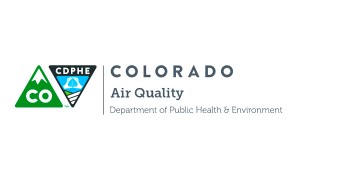
Action Day for Visibility
Denver Metro
Indoor Burning Restrictions in Effect
This is the Denver Metro Air Pollution Forecast effective 4PM on Monday, December 18, 2017:
An Action Day for Visibility is now in effect for the seven-county Denver-Boulder metropolitan area. Indoor Burning Restrictions and requests to limit driving are now in effect until at least 4 PM Tuesday, December 19, 2017. Poor visibility and an exceedance of the state visibility standard are expected on Tuesday. Otherwise, good or moderate air quality conditions are expected. No other air quality advisories are in effect.
Light winds and stagnant overnight conditions will lead to Poor visibility on Tuesday.
For statewide conditions, forecasts and advisories, visit:
http://www.colorado.gov/airquality/colorado_summary.aspxA poorly maintained vehicle pollutes more than a well maintained one. If you must drive, properly maintain your vehicle. We’ll all breathe easier!
At 2PM (MST), Monday, 12/18/2017 the highest AQI value was 65 for Particulate less than 2.5 micrometers which indicates Moderate air quality. Respiratory symptoms possible in unusually sensitive individuals, possible aggravation of heart or lung disease in people with cardiopulmonary disease and older adults. Unusually sensitive people should consider reducing prolonged or heavy exertion.
Front Range Air Quality Forecast & Colorado Smoke Outlook
FRONT RANGE AIR QUALITY FORECAST:
Monday, December 18, 2017, 2:30 PM MSTOzone concentrations are expected to be in the Good category on Monday and Tuesday.
Fine Particulate Matter concentrations are expected to be in the Good to Moderate category on Monday and Tuesday. Moderate concentrations of fine particulates are most likely in the Denver Metro Area and northward along the Front Range urban corridor, including Fort Collins and Greeley. In these areas unusually sensitive people should consider reducing prolonged or heavy exertion on Monday and Tuesday.
Carbon Monoxide concentrations are expected to be in the Good category on Monday and Tuesday.
Nitrogen Dioxide concentrations are expected to be in the Good to Moderate range on Monday and Tuesday. Moderate concentrations of nitrogen dioxide are most likely for locations within the Denver Metro area near busy roadways, particularly between the hours of 5-9 PM on Monday evening, and again between the hours of 6-10 AM on Tuesday morning. In these areas unusually sensitive people should consider reducing prolonged or heavy outdoor exertion on Monday and Tuesday.
Visibility is expected to be Moderate to Poor on Tuesday.
COLORADO SMOKE OUTLOOK:
Monday, December 18, 2017, 2:30 PM MSTLight to moderate smoke is possible near prescribed fires and small wildfires around the state.
What if there is a wildfire or smoke in your area?
The focus of the Colorado Smoke Outlook is on large fires (e.g., greater than 100 acres in size). Nevertheless, smoke from smaller fires, prescribed fires, and/or smoke from new fires not yet known to CDPHE air quality meteorologists may cause locally heavy smoke. If there is smoke in your neighborhood, see the public health recommendations below.
Public health recommendations for areas affected by smoke: If smoke is thick or becomes thick in your neighborhood you may want to remain indoors. This is especially true for those with heart disease, respiratory illnesses, the very young, and the elderly. Fine particulates may reach the Unhealthy category where smoke is heavy. Consider limiting outdoor activity when moderate to heavy smoke is present. People with heart or lung disease, older adults, and children should avoid prolonged or heavy exertion; everyone else should reduce prolonged or heavy exertion. Consider relocating temporarily if smoke is present indoors and is making you ill. IF VISIBILITY IS LESS THAN 5 MILES IN SMOKE IN YOUR NEIGHBORHOOD, SMOKE HAS REACHED LEVELS THAT ARE UNHEALTHY.
HELP US SPREAD THE NEWS
COMMENT, Like, Follow & SHARE @I70Scout
CURRENT EDITION
WEATHER & TRAFFIC PUZZLES RECENT NEWS ADVERTISE WITH US